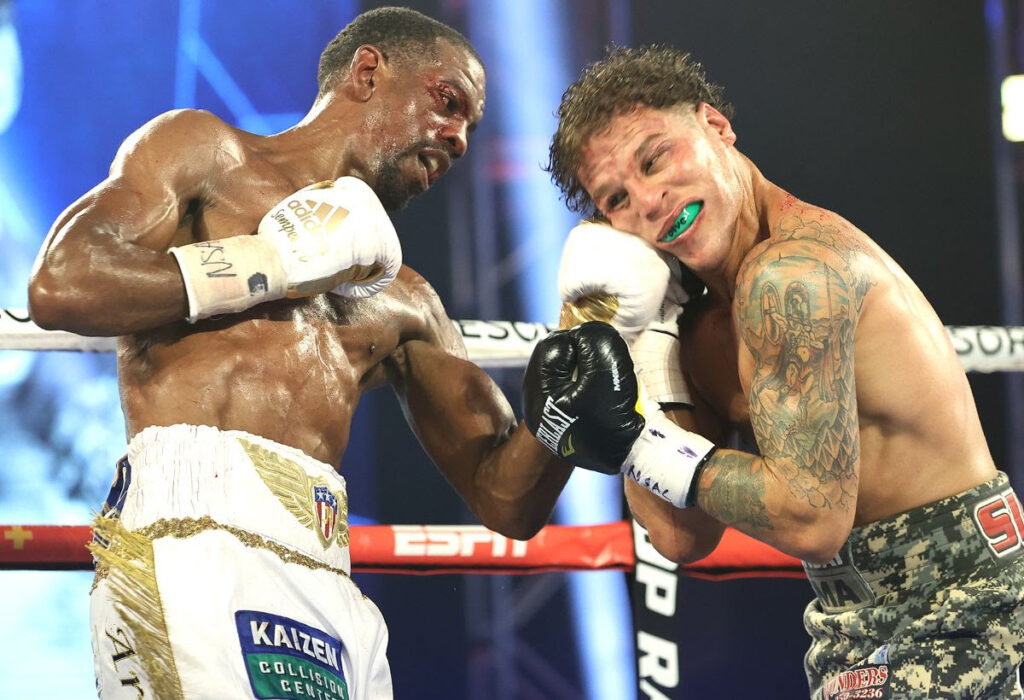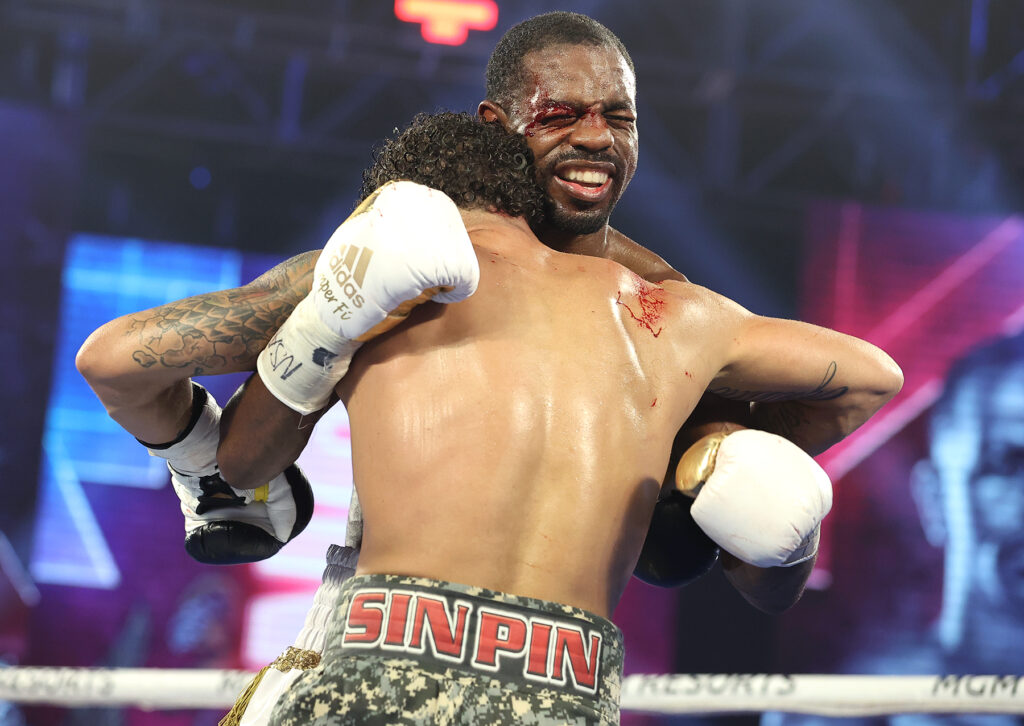IBHOF inductee Graham Houston reflects on the weekend’s unsightly and ultimately chaotic encounter between WBO 130lbs champion Jamel Herring and Puerto Rican challenger Jonathan Oquendo.
What a comedy of errors we had in Saturday’s junior lightweight title fight between Jamel Herring and Jonathan Oquendo in Las Vegas. It was so confusing, one hardly knows where to begin.
OK, let’s start with the bare result. Herring was declared winner by disqualification at the end of the eighth round.
For those who haven’t seen the full fight, what happened was that Herring suffered a cut over the right eye after a clash of heads in the fifth round. Referee Tony Weeks waited a few moments before calling a time out in the fifth.
And here is where the confusion began. Referee Weeks approached the commission table and said, pointing to his head: “Intentional coming together.” He repeated these words: “Intentional coming together.”
What did that mean? Both men to blame for the collision? Accidental head clash? It was only after the fifth round was over that Weeks told the judges to take a point from Oquendo for an intentional butt.
And, under the Association of Boxing Commissions unified rules, the rule is that two points should be deducted for an intentional foul. (As I understand it, the actual determination that Oquendo had butted Herring intentionally was not made until after instant replay had been viewed at ringside; Weeks did not immediately instruct the judges to deduct one point from Oquendo’s score.)
Then, after eight rounds, with Herring obviously in front on points, having dropped Oquendo in the third for a 10-8 round and with the challenger having been docked a point, the fight was over. Herring told the commission doctor he couldn’t see.
More confusion. Herring’s trainer Brian McIntyre was concerned that Herring would lose the fight by retirement. Weeks reassured McIntyre that an intentional head butt had been determined.
We now move to the commission table. Nevada commissioner Bob Bennett correctly ruled that the fight should go to the scorecards. Tony Weeks seemed to be arguing for a DQ. There was a lengthy delay while the mess was sorted out.
ESPN+ streaming-service analyst Timothy Bradley wasn’t thrilled with the ending and even suggested that Herring gamed the system. “He wanted out!” Bradley asserted. “I’ve gotta tell you that. He wanted out! That’s the problem that I’m having right now, because I’m trying to digest all of this, and I’m saying: ‘OK, the reason why you can’t see is because you’ve got blood dripping down in your eye … You can see once they clear that up!’ To me, I honestly feel like he gave up.”
The MC’s announcement, when it finally came, was that Oquendo had been disqualified due to “repeated intentional head butts”.
Really?
I didn’t see the referee give Oquendo a stern warning — or “hard warning” as they call it in Nevada.

Watching the video as closely as I could, it seemed to me that Weeks twice motioned to Oquendo to watch his head in the first round. He told Oquendo not to hit on the back of the head in the same round.
In round two, Oquendo’s head bumped into Herring’s face. But if Oquendo was cautioned, I missed it.
On to round four, and the referee motioned to Oquendo not to hit behind the head.
Then we had the head clash in the fifth round.
The referee signalled to Oquendo to keep his punches up in the eighth round.
And that was it.
If there were “repeated intentional head butts”, then where were the repeated warnings? If there were repeated warnings, I sure as heck missed them.
The whole thing is another boxing mishmash. And it comes so soon after the missed knockout by the referee in Oklahoma.
You know what? I’m starting to hanker for the days when things were simpler in boxing. The days when, if a referee felt a boxer had fouled intentionally, he would simply disqualify that boxer. When, if a boxer said he could not continue, sorry, he lost the fight.
And, yes, the days before technical decisions.
Too often since the technical decision rule was introduced we have seen a boxer bail out, and it’s always: “I can’t see.”

Photo: Mikey Williams/Top Rank.
The ringside doctor isn’t going to argue with a fighter who says he can’t see.
I don’t need to trawl through boxing history to name all the fighters who have battled through blood and bruises, who have fought on with one eye closed, or a broken jaw, who have endured and toughed it out even in a hopeless cause.
Sure, there were injustices. Say, Eddie Avoth being stopped due to a cut over the eye caused by a head clash in a British title fight against rugged Young McCormack. Or Brian London halted due to a cut caused by Dick Richardson coming in with his head in their European heavyweight title fight. Both Avoth and London were well on their way to winning.
However, these things went with the territory.
Now we have the technical decision rule giving a get out of jail card to a boxer who doesn’t like the way a fight is progressing. (As regards Jamel Herring, he was, of course, declared winner by DQ, not, as should have been the case, by technical decision.)
And I’m not even sure that Oquendo deliberately butted Herring. Oquendo was coming in with his head, sure, but he’s a short, stocky fighter and that’s his style. What was he supposed to do: Stand back and get his ears boxed off?
Many fighters through ring history have employed a rough, tough style, some rougher and tougher than others. We’ve all heard boxing commentators observe: “He can’t win a boxing match; he’s got to get inside and rough him up.” (Or wording to that effect.)
Oquendo simply tried to get inside and rough up Herring. He was fighting a rough fight, but it is debatable if he intentionally butted Herring.
So, what should have been a Herring showcase became another unsatisfactory night at the office for boxing.
It never ends.
- Here is the Association of Boxing Commissions rule regarding intentional fouls: “If an intentional foul causes an injury and the bout is allowed to continue, and the injury results in the bout being stopped any time after the fourth (4th) round, the injured boxer will win by technical decision if he is ahead on the score cards; and the bout will result in a technical draw if the injured boxer is behind or even on the score cards.“